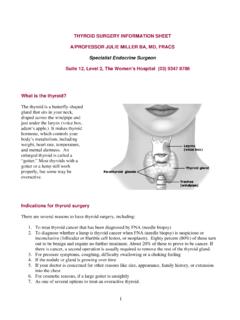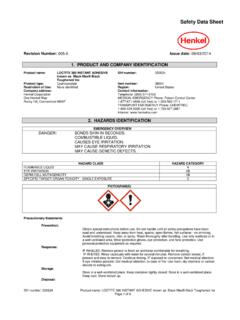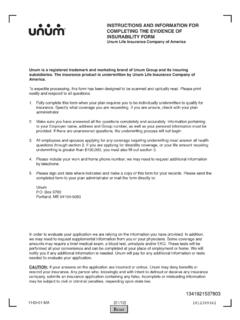Transcription of Amiodarone Hydrochloride 150 mg/3 mL Name of the …
1 1 Amiodarone Hydrochloride 150 mg/3 mL 01102015 NEW ZEALAND DATA SHEET Amiodarone Hydrochloride 150 mg/3 mL Amiodarone Hydrochloride Concentrated Injection 150 mg/3 mL Name of the Medicine Non-proprietary name Amiodarone Hydrochloride Chemical structure CAS number 1951-25-3 Description The active ingredient of Amiodarone Hydrochloride 150 mg/3 mL is Amiodarone Hydrochloride (2-n-butyl-3(4-(2-diethylaminoethoxy)-3, 5-diiodobenzoyl) benzofuran Hydrochloride ). Amiodarone Hydrochloride is a Class III antiarrhythmic agent. Amiodarone Hydrochloride is a fine white crystalline powder. It is slightly soluble in water and is soluble in alcohol and chloroform. It is an amphiphilic compound and contains iodine in its formulation.
2 The excipients of Amiodarone Hydrochloride 150 mg/3 mL are polysorbate 80, benzyl alcohol and water for injections, as well as hydrochloric acid and sodium hydroxide for pH adjustment. Each 3mL ampoule contains of benzyl alcohol and approximately 56mg iodine. 2 Amiodarone Hydrochloride 150 mg/3 mL 01102015 Pharmacology Actions Amiodarone is a Class III antiarrhythmic agent prolonging the action potential duration and hence refractory period of atrial, nodal and ventricular tissues, thereby giving a very broad spectrum of activity. An increase in the refractory period of the atrial cells is a major contributing action to the control of atrial tachyarrhythmias. A reduction in the permeability of the A-V node, both anterograde and retrograde, explains the efficacy of the medicine in nodal tachycardias caused by re-entry through the A-V node.
3 Its action on ventricular arrhythmias is explained by a number of mechanisms. The effect on the atrium and A-V node results in a reduction in the frequency of stimuli reaching the ventricle thus giving the ventricular cell mass time to repolarise in cases where there has been desynchronisation of the refractory periods. Furthermore, a lengthening of the refractory period of the His-Purkinje system and ventricular contractile fibres reduces or prevents micro re-entry. Amiodarone increases coronary blood flow, decreases cardiac oxygen requirements without producing negative inotropic effects and also suppresses ectopic pacemakers, and this is particularly valuable in arrhythmias associated with ischaemic damage or angina pectoris.
4 The site and mode of action of Amiodarone can be summarised in terms of its effect on myocardial electrophysiology. Myocardial electrophysiology Sinus node: It decreases sinus automaticity by reducing the slow diastolic depolarisation gradient in the nodal cell. This is a direct effect and is not mediated through the sympathetic or parasympathetic system. Atrio-ventricular (A-V) node: It reduces the speed of conduction and increases the refractory period of the A-V node. His-Purkinje system: It increases the refractory period but does not modify the speed of conduction of the His-Purkinje system. Contractile fibres: It increases the action potential but does not alter the rate of depolarisation of the atrial or ventricular myocardial cells; an effect that is more marked in the atria than the ventricles.
5 3 Amiodarone Hydrochloride 150 mg/3 mL 01102015 Pharmacokinetics The following information may not necessarily be related to administration of Amiodarone , however is included for reference purposes: In general, pharmacokinetic data relating to Amiodarone are incomplete. Amiodarone is incompletely and erratically absorbed following oral administration. Absolute bioavailability ranges from 22 - 86% but there is extensive inter-subject variation. First-pass metabolism in the gut wall and/or in the liver may be a factor in determining the availability of the medicine. A HPLC method is available for estimation of Amiodarone plasma levels. However, the value of this is limited because the correlation of therapeutic effect and plasma level has not been established.
6 Steady state plasma levels are generally around 1 - 2 g/mL although inter-subject variations are common. Considerably higher values have been reported, especially subsequent to large single doses. Peak plasma concentrations of g/mL have been recorded following a single dose of 1,600mg and g/mL after a single dose of 800mg. Steady state levels of g/mL and g/mL have been recorded after daily oral dosing in the range of 800 - 1,800mg. The half-life of Amiodarone is long and with chronic oral dosing can be from 14 110 days but is usually in the range 14 - 59 days. The principal metabolite of Amiodarone , which has been detected in the plasma and other tissues, is desethylamiodarone.
7 This metabolite is reported to have a longer half-life than Amiodarone , 10 hours after a single dose of Amiodarone and 60 - 90 days after chronic dosing with Amiodarone . The activity of this metabolite is not known. Amiodarone is highly protein bound and is thought to bind strongly to protein at concentrations of 10 g/mL. It is believed that most of the medicine is excreted via the liver and gastrointestinal tract by biliary excretion. There may be some hepatic recirculation. The apparent volume of distribution after oral (200 - 400mg) Amiodarone is Amiodarone appears to accumulate in adipose tissue and in highly perfused organs (lung, bone marrow, adrenals, liver, pancreas, heart, spleen and kidney).
8 The concentration of Amiodarone in packed red blood cells is approximately 60% of that in plasma. Indications Treatment should be initiated only under hospital or specialist supervision. Tachyarrhythmias associated with Wolff-Parkinson-White Syndrome. All types of tachyarrhythmias including supraventricular, nodal and ventricular tachycardias, atrial flutter and fibrillation; ventricular fibrillation; when other agents cannot be used. The injection is to be used when a rapid response is required. 4 Amiodarone Hydrochloride 150 mg/3 mL 01102015 Contraindications Known hypersensitivity to iodine or Amiodarone or to any of the excipients. Pregnancy and lactation (see Use in Pregnancy and Use in Lactation).
9 In patients in whom bradycardia or AV block is sufficient to cause syncope, patients with sick sinus syndrome (risk of sinus arrest) or with severe atrioventricular conduction disorders, Amiodarone Hydrochloride 150 mg/3 mL should only be used in conjunction with a pacemaker. Sinus bradycardia and sino-atrial heart block. Amiodarone Hydrochloride 150 mg/3 mL is contraindicated in patients with evidence, or a history of thyroid dysfunction. Combined therapy with medicines which may induce torsades de pointes (see Interactions). Amiodarone Hydrochloride 150 mg/3 mL is contraindicated in the case of hypotension, severe respiratory failure, cardiomyopathy, heart failure, circulatory collapse and severe arterial hypotension.
10 It is also contraindicated in bi- or trifascicular conduction disorders, unless a permanent functioning pacemaker is fitted, or unless the patient is in a special care unit and Amiodarone is used under the cover of electrosystolic pacing. Due to the benzyl alcohol content, Amiodarone Hydrochloride 150 mg/3 mL is contraindicated in neonates (children less than one month of age) or premature neonates (see Warnings and Precautions Paediatric use). Warnings and Precautions It is recommended to perform an ECG and serum potassium measurement before treatment initiation. Caution should be exercised in case of hypotension, severe respiratory failure, uncompensated or severe heart failure.
















